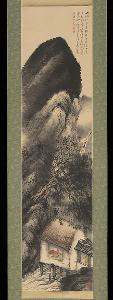Yasuda Hanpo
安田半圃;Yasuda Hanpo
Place: Niigata
Born: 1889
Death: 1947
Biography:
, a renowned Japanese Nanga artist, was active during the Meiji and Taishō eras. Born in Niigata prefecture, Japan in 1889, he became best known for his landscape paintings, which showcased his unique style and technique.
Early Life and Training
Hanpo's early life and training played a significant role in shaping his artistic style. He was born into a family of artists and was trained in the traditional Japanese art forms from a young age. His talent and dedication earned him recognition, and he became a prominent figure in the Japanese art scene.
Artistic Style
Hanpo's artistic style was characterized by his use of vibrant colors, bold brushstrokes, and intricate details. He was heavily influenced by Chinese literati painting and calligraphy, which emphasized individual expression and the pursuit of personal enlightenment. His paintings typically depicted scenes of nature, such as flowers, birds, and landscapes.
Notable Works
Some of Hanpo's notable works include Fishing in Reclusion, a stunning landscape painting that showcases his mastery of light and color. This painting is a prime example of his unique style and technique, which has been widely admired by art enthusiasts.
Museums and Collections
Hanpo's work can be found in various museums and collections around the world, including Menard Art Museum, Hokkaido Museum of Modern Art, and Shimane Art Museum. His paintings are highly valued for their beauty, elegance, and cultural significance.
Legacy
Hanpo's legacy continues to be celebrated by art enthusiasts and scholars alike. His unique style and technique have influenced many artists, and his work remains a testament to the beauty and elegance of Japanese art. Yasuda Hanpo's contributions to the world of art are undeniable, and his paintings continue to inspire and delight audiences around the world.
- Nanga Art Movement: Hanpo was a prominent figure in the Nanga art movement, which emerged during the Edo period.
- Yasuda Hanpo's work is characterized by his use of vibrant colors and bold brushstrokes.
- His paintings typically depicted scenes of nature, such as flowers, birds, and landscapes.
- Hanpo's legacy continues to be celebrated by art enthusiasts and scholars alike.
Hanpo died in 1947, but his work continues to be admired and studied by art enthusiasts and scholars. His unique style and technique have left a lasting impact on the world of Japanese art, and his paintings remain a testament to the beauty and elegance of this traditional art form. Yasuda Hanpo's legacy is a reminder of the importance of preserving and celebrating traditional Japanese art, and his work continues to inspire and delight audiences around the world.

